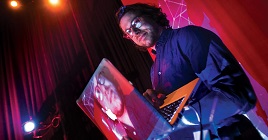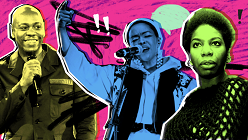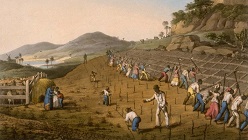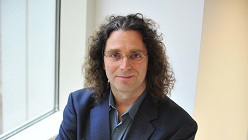By Jessica Weiss ’05
In 1964, after the assassination of civil rights leader Medgar Evers in Mississippi and the killing of four Black girls in the 16th Street Baptist Church bombing in Alabama, Nina Simone wrote what became one of the most famous protest songs of the civil rights movement: “Mississippi Goddam,” about the absurdity of being told to calmly wait for progress in the face of relentless violence.
According to Associate Professor of American Studies La Marr Jurelle Bruce, the furious song and its performance—in which Simone pounds the piano, furrows her brow and contorts her face in rage as she sings—are acts of radical, ethical “madness.”
Simone was diagnosed with bipolar disorder and schizophrenia. But among audiences unaware of her diagnoses, Bruce says she was sometimes called “crazy” for the sheer fact of her defiant Black womanhood. He says that she mobilized madness to dramatize the effects of anti-Blackness, to disrupt her (mostly white) audience’s complacency and to model madness as a powerful political and artistic strategy.
It’s among the case studies in Bruce’s new book, “How to Go Mad Without Losing Your Mind,” which will be published by Duke University Press this month. In it, he explores the Black radical creativity of artists like Simone, Richard Pryor, Gayl Jones, Ntozake Shange, Lauryn Hill and Kendrick Lamar to shed light on various manifestations of madness in the face of anti-Blackness.
We spoke to Bruce about studying madness and why the publication of his book is so timely.
Your book is situated in the emerging, interdisciplinary field of mad studies. Can you explain what that is?
Mad studies brings together psychiatrists, social workers, critical race theorists, legal theorists, historians of science and medicine, feminists, abolitionists, mad-identified people and others to interrogate the social construction of psychiatry and mental illness—and to illuminate lived experiences of “madness.” Moreover, mad studies insists on honoring the lives and perspectives of people labeled “mad” by psychiatry and/or society. In this context, madness is not merely an object of analysis; it is a subject position for critical thought and decisive action. At its best, mad studies pursues the material and existential liberation of mad people.
All the while, mad studies must contend with the profound stigma and misinformation surrounding madness. Consider this: Many people's “education” about severe mental illness comes from horror films and suspense thrillers. For many Americans in the 1960s, for example, the film “Psycho” was regarded as primary source material for thinking about multiple personality disorder. This creates dangerous distortions. Mad studies works to resist and dispel such distortions. At its best, mad studies pursues the material and existential liberation of mad people.
You created a framework that you use to categorize forms of madness in the book. Can you tell us about that?
In “How to Go Mad,” I propose a four-part framework to ponder the meaning and matter of madness in modernity. The categories include (1) the lived experience of psychic turmoil and unruliness of mind; (2) the psychiatric diagnosis of serious mental illness; (3) the emotional and existential state known as “rage”; and (4) any drastic deviation from psychosocial norms. Regarding this latter category, any person, idea or behavior that perplexes and vexes psychosocial norms is liable to be called “crazy.”
Can you give folks a sense of what’s explored in the book, perhaps a taste of your analysis of Lauryn Hill’s “madness”?
Hill’s debut solo album, “The Miseducation of Lauryn Hill,” sold more copies in its first week than any woman’s debut album in the history of the Billboard charts. At the 1999 Grammys, “Miseducation” was the first hip hop album ever awarded best album of the year. Hill was a critical darling and commercial juggernaut, seemingly perched on top of the world. And then, disillusioned with celebrity, she decided to retreat from the spotlight, refuse the trappings of fame and acclaim, shave her head, weep on stage and forgo lucrative commercial prospects. In other words, she decided to deviate from a profit-driven, image-obsessed pop culture norm. As a result, many pundits claimed she’d gone mad. In the book, I explore how she activates madness in lyrics, performances and interviews to challenge conventional notions of sanity, femininity, blackness and value.
Dave Chapelle was also called crazy when he stepped away from the spotlight.
Yes. For having the temerity to turn down a $50 million contract with Comedy Central in 2005, Chappelle was widely maligned as crazy. Remarkably, his retreat from the spotlight brought him to Durban, South Africa. At the time, there was much hullabaloo about how Chappelle “went crazy” and “went to Africa”—as though the two were convergent journeys. I found this fascinating alongside the history of anti-Black and anti-African philosophy: Enlightenment-era philosophers like Georg Wilhelm Friedrich Hegel and David Hume envisioned the continent of Africa as a wasteland of unreason, savagery and madness. This sort of rationale seemed to be at work in rumors about Chappelle’s trip. It was as though Africa was the ground zero of madness, the epicenter of madness, and Chappelle—a madman—went on a pilgrimage there. To the contrary, Chappelle claimed he went to South Africa to escape the madness of Hollywood.
The way you write is really lyrical and took me on a journey. There’s this sense I got that you really wanted me, as a reader, to touch and feel your words—almost like you wanted me to experience madness itself.
Thank you. It’s gratifying and heartening to hear that the book moved you in this way. Concerning that “lyrical” quality: I believe that beauty is pedagogical. Beauty can grab hold of people’s attention, ignite their imagination, and avail them to persuasion and revelation. At the same time, I hope that the lyricism of my prose doesn’t seem to romanticize madness as something categorically beautiful. Yes, madness sometimes entails beauty—but it might also entail terror, wonder, turmoil, violence, ecstasy, power, abjection, ugliness and beyond.
Because madness resists knowing, we must sometimes find recourse and take solace in feeling instead. In this book, feeling is at least as important as knowing. I try to infuse my writing with an intimate, visceral, sensuous quality. I want to give people something they can feel.
Between the pandemic and protests, we’re living in an era that many people would characterize as crazy. It feels like a ripe time for your book to hit the world.
Talk of “craziness” suffuses public discourse about race, politics, violence and celebrity. A prime example on the political front: During Donald Trump’s presidency, many pundits insisted that he was mentally ill, as though his erratic behavior, astounding incompetence and colossal malice must be symptoms of mental illness. Meanwhile, Trump framed such criticisms as delusional and accused his detractors of suffering from “Trump Derangement Syndrome.” The accusation of madness is a powerful weapon in public debate, wielded to degrade and to discredit.
Madness is also a useful analytic for pondering the collective trauma of anti-Black police violence. Experiencing and/or witnessing such violence engenders terror, hurt and grief that can drive a person mad. What I mean is that state-sanctioned anti-Blackness can incite unruliness of mind; it can instigate outrage; it can inspire a rejection of (anti-Black) psychosocial norms; and it can also induce mental illness.
And then, of course, there is COVID. For a very long time, people across the globe will be processing the psychic residues of this catastrophe. Social isolation, fear of contagion, scarcity of human touch, rupture from the “normal” and profound grief have been maddening for many. I’m eager to study the art generated in response to, about and amid COVID. Some of that art will be mad and maddening, for sure.














